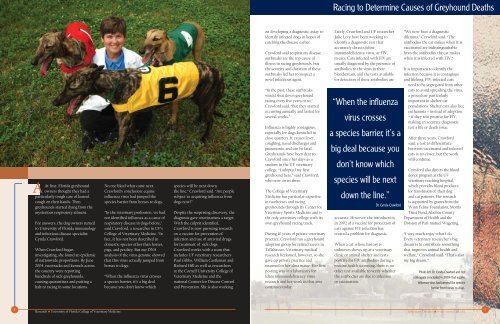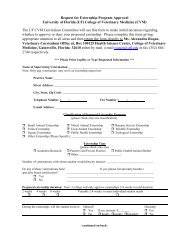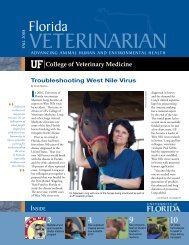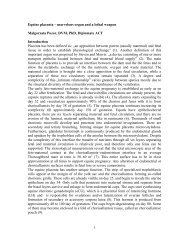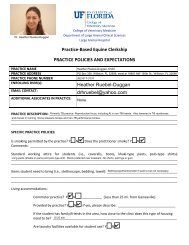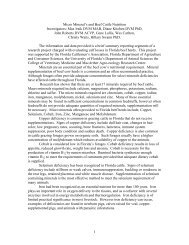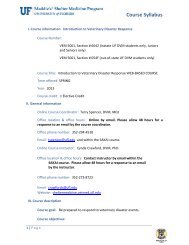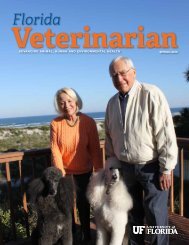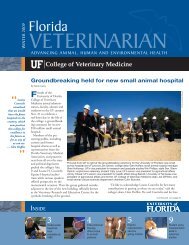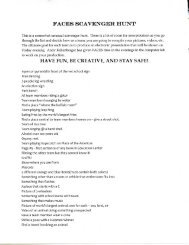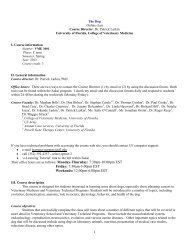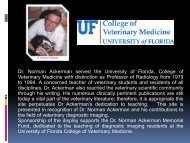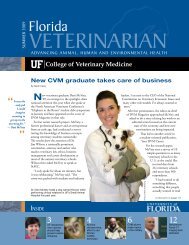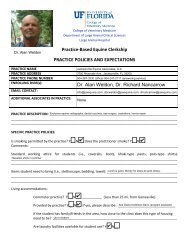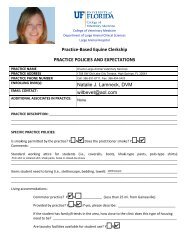College of Veterinary Medicine Research Brochure
College of Veterinary Medicine Research Brochure
College of Veterinary Medicine Research Brochure
- No tags were found...
Create successful ePaper yourself
Turn your PDF publications into a flip-book with our unique Google optimized e-Paper software.
Racing to Determine Causes <strong>of</strong> Greyhound DeathsAAt first, Florida greyhoundowners thought they had aparticularly tough case <strong>of</strong> kennelcough on their hands. Thengreyhounds started dying from themysterious respiratory ailment.For answers, the dog owners turnedto University <strong>of</strong> Florida immunologyand infectious disease specialistCynda Crawford.When Crawford beganinvestigating, she found an epidemic<strong>of</strong> nationwide proportions. By June2004, racetracks and kennels acrossthe country were reportinghundreds <strong>of</strong> sick greyhounds,causing quarantines and putting ahalt to racing in some locations.No one liked what came next.Crawford’s conclusion: equineinfluenza virus had jumped thespecies barrier from horses to dogs.“In the veterinary pr<strong>of</strong>ession, we hadnot identified influenza as a cause <strong>of</strong>respiratory disease in dogs before,”said Crawford, a researcher in UF’s<strong>College</strong> <strong>of</strong> <strong>Veterinary</strong> <strong>Medicine</strong>. “Infact, it has not been described indomestic species other than horses,pigs, and poultry. But our DNAanalysis <strong>of</strong> the virus genome showedthat this virus actually jumped fromhorses to dogs.“When the influenza virus crossesa species barrier, it’s a big dealbecause you don’t know whichspecies will be next downthe line,” Crawford said. “Are peoplesubject to acquiring influenza fromdogs now?”Despite the surprising discovery, thediagnosis gave veterinarians a target.With the culprit identified,Crawford is now pursuing researchon a vaccine for prevention <strong>of</strong>infection and use <strong>of</strong> antiviral drugsfor treatment <strong>of</strong> sick dogs.Crawford works with a team thatincludes UF veterinary researchersPaul Gibbs, William Castleman andRichard Hill as well as researchersat the Cornell University <strong>College</strong> <strong>of</strong><strong>Veterinary</strong> <strong>Medicine</strong> and thenational Centers for Disease Controland Prevention. She is also workingon developing a diagnostic assay toidentify infected dogs in hopes <strong>of</strong>catching the disease earlier.Crawford said respiratory diseaseoutbreaks are the top cause <strong>of</strong>illness in racing greyhounds, butthe severity and duration <strong>of</strong> theseoutbreaks led her to suspect anovel infectious agent.“In the past, these outbreakswould shut down greyhoundracing every five years or so,”Crawford said. “But they startedoccurring annually and lasted forseveral weeks.”Influenza is highly contagious,especially for dogs kenneled inclose quarters. It causes fever,coughing, nasal discharges andpneumonia, and can be fatal.Greyhounds have been dear toCrawford since her days as astudent in the UF veterinarycollege. “I adopted my firstgreyhound here,” said Crawford,who now owns three.The <strong>College</strong> <strong>of</strong> <strong>Veterinary</strong><strong>Medicine</strong> has particular expertisein racehorses and racinggreyhounds through its Center for<strong>Veterinary</strong> Sports <strong>Medicine</strong> and isthe only veterinary college with itsown greyhound racing track.During 10 years <strong>of</strong> private veterinarypractice, Crawford ran a greyhoundadoption group for retired racers inTallahassee. <strong>Veterinary</strong> medicalresearch beckoned, however, so shegave up private practice andreturned to her alma mater. Her firstposting was in a laboratory forfeline immunodeficiency virusresearch and her work in that areacontinues today.Lately, Crawford and UF researcherJulie Levy have been working toidentify a diagnostic test thataccurately detects felineimmunodeficiency virus, or FIV,in cats. Cats infected with FIV areusually diagnosed by the presence <strong>of</strong>antibodies to the virus in theirbloodstream, and the tests availablefor detection <strong>of</strong> these antibodies are“When the influenzavirus crossesa species barrier, it’s abig deal because youdon’t know whichspecies will be nextdown the line.”Dr. Cynda Crawfordaccurate. However, the introductionin 2002 <strong>of</strong> a vaccine for protection <strong>of</strong>cats against FIV infection hascreated a problem for diagnosis.When a cat whose history isunknown shows up at a veterinaryclinic or animal shelter and testspositive for FIV antibodies during aroutine health screening, there is noother test available to verify whetherthe antibodies are due to infectionor vaccination.“We now have a diagnosticdilemma,” Crawford said. “Theantibodies the cat makes when it isvaccinated are indistinguishablefrom the antibodies the cat makeswhen it is infected with FIV.”It is important to identify theinfection because it is contagiousand lifelong. FIV-infected catsneed to be segregated from othercats to avoid spreading the virus,a procedure particularlyimportant in shelter catpopulations. Shelter cats also faceeuthanasia – instead <strong>of</strong> adoption– if they test positive for FIV,making an accurate diagnostictest a life or death issue.After three years, Crawfordsaid, a test to differentiatebetween vaccinated and infectedcats is no closer, but the workwill continue.Crawford also directs the blooddonor program at the UFveterinary teaching hospital,which provides blood productsfor transfusion <strong>of</strong> their dogand cat patients. Her researchis supported by grants from theWinn Feline Foundation, MorrisTrust Fund, Alachua CountyDepartment <strong>of</strong> Health and theDivision <strong>of</strong> Pari-mutuel Wagering.“I very much enjoy what I do.Every veterinary researcher’s bigdream is to contribute somethingthat improves animal health andwelfare,” Crawford said. “That’s alsomy big dream.”Photo left: Dr. Cynda Crawford and hercolleagues concluded in 2004 that equineinfluenza virus had jumped the speciesbarrier from horses to dogs.8<strong>Research</strong> • University <strong>of</strong> Florida <strong>College</strong> <strong>of</strong> <strong>Veterinary</strong> <strong>Medicine</strong>••Infectious Diseases • www.vetmed.ufl.edu9


